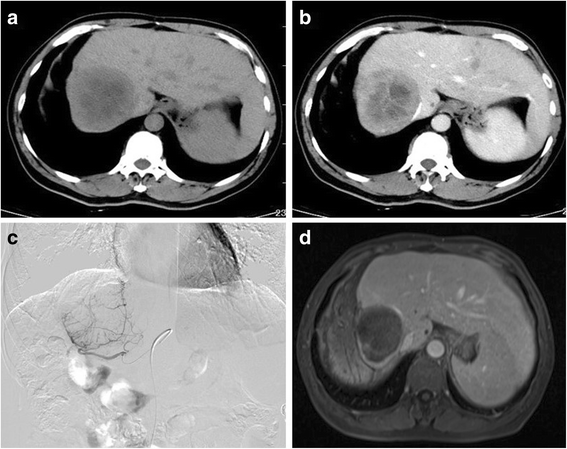CalliSpheres drug-eluting beads versus lipiodol transarterial chemoembolization in the treatment of hepatocellular carcinoma: a short-term efficacy and safety study
- PMID: 29587773
- PMCID: PMC5870383
- DOI: 10.1186/s12957-018-1368-8
CalliSpheres drug-eluting beads versus lipiodol transarterial chemoembolization in the treatment of hepatocellular carcinoma: a short-term efficacy and safety study
Abstract
Background: The present study aimed to evaluate the short-term efficacy and safety of drug-eluting beads transarterial chemoembolization (DEB-TACE) with CalliSpheres Beads loaded with doxorubicin (DOX) in the treatment of Chinese patients with hepatocellular carcinoma (HCC) compared to conventional TACE (cTACE).
Methods: A total of 54 patients with HCC treated by TACE from June 2016 to February 2017 were retrospectively analyzed. These included 24 cases in the DEB-TACE group and 30 cases in the cTACE group. The clinical efficacy, tumor recurrence rate, and complications were compared between the two groups. Furthermore, liver function tests and alpha-feto protein levels were compared between the two groups before and at 1 week and 1 month after interventional treatment.
Results: There were no significant differences in baseline characteristics (p > 0.05). Tumor response rates and disease control rates in the DEB-TACE group were significantly higher than those in the cTACE group at 3 and 6 months after treatment (p < 0.05). Recurrence rates at 6 months were significantly higher for cTACE compared to DEB-TACE (43.3 vs. 16.7%; p = 0.036). At 1 month, the AFP level in the DEB-TACE group was significantly lower than that in the cTACE group (p = 0.008). At the end of follow-up, four cases in the DEB-TACE group and two cases in the cTACE group were treated with salvage surgery after downstaging the disease. Liver function of both groups improved at 1 month. However, alanine aminotransferase, aspartate aminotransferase, and total bilirubin levels in the DEB-TACE group were better than those in the cTACE group (p < 0.05). The incidence of DOX-related complications in the DEB-TACE group was significantly lower than in the cTACE group (p < 0.05).
Conclusion: The short-term efficacy of DEB-TACE is better, and the complication rates are lower compared to cTACE in the treatment of Chinese patients with HCC. However, long-term clinical efficacy and survival benefit should be analyzed in future studies.
Keywords: CalliSpheres Beads; Drug-eluting beads; Efficacy; Hepatocellular carcinoma; Safety; Transarterial chemoembolization.
Conflict of interest statement
Ethics approval and consent to participate
The institutional review board of the Zhongnan Hospital of Wuhan University approved this retrospective study and waived the requirement for patient informed consent.
Consent for publication
Not applicable
Competing interests
This manuscript contains original material that has not been published or submitted to any other journal. The authors declare that they have no competing interests.
Publisher’s Note
Springer Nature remains neutral with regard to jurisdictional claims in published maps and institutional affiliations.
Figures

References
-
- Lewandowski RJ, Mulcahy MF, Kulik LM, Riaz A, Ryu RK, Baker TB, Ibrahim SM, Abecassis MI, Miller FH, Sato KT, et al. Chemoembolization for hepatocellular carcinoma: comprehensive imaging and survival analysis in a 172-patient cohort. Radiology. 2010;255(3):955–965. doi: 10.1148/radiol.10091473. - DOI - PMC - PubMed
Publication types
MeSH terms
Substances
LinkOut - more resources
Full Text Sources
Other Literature Sources
Medical
Miscellaneous

